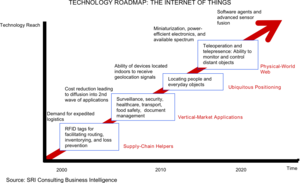 Probably the biggest change coming soon to crop farming is precision agriculture. This applies GPS and sensors to monitor field conditions like water, soil, nutrients, weeds, etc. to optimize the application of water, pesticides, and fertilizers in order to maximize the crop yields in different parts of the farm. Anybody who has ever farmed knows that fields are not uniform in nature and that the various factors that produce the best crops differ even within one field.
Probably the biggest change coming soon to crop farming is precision agriculture. This applies GPS and sensors to monitor field conditions like water, soil, nutrients, weeds, etc. to optimize the application of water, pesticides, and fertilizers in order to maximize the crop yields in different parts of the farm. Anybody who has ever farmed knows that fields are not uniform in nature and that the various factors that produce the best crops differ even within one field.
Precision agriculture is needed if we are to feed the growing world population, which is expected to reach almost 10 billion by 2050. As a planet we will need to get the best possible yield out of each field and farm. This might all have to happen against a back drop of climate change which is playing havoc with local weather conditions.
A number of farmers have started the process of gathering the raw data needed to understand their own farms and conditions. Farmers know the best and worst sections of their fields, but they do not understand the subtle differences between all of the acreage. In the past farmers haven’t known the specific yield differences between the various microcosms within their farm. But they are now able to gather the facts needed to know their land better. It’s a classic big data application that will recommend specific treatments for different parts of a field by sifting through and making sense of the large numbers of monitor readings.
In order to maximize precision agriculture new automated farm machinery will be needed to selectively treat different parts of the fields. The large farm equipment manufacturers expect that farming will be the first major application for drones of all types. They are developing both wheeled vehicles and aerial drone systems that can water or treat sections of the fields as needed.
This is a major challenge because farming has historically been a somewhat low technology business. While farms have employed expensive equipment, the thinking part of the business was always the responsibility of each farmer, and the farmers with the best knowledge and experience would typically out-produce their neighbors. But monitoring can level the playing field and dramatically increase yields for everybody.
There are several hurdles in implementing precision agriculture. First is access to the capital needed to buy the monitors and the equipment used to selectively treat fields. This need for capital is clearly going to favor large farms over small ones and will be yet one more factor leading to the consolidation of small farms into larger enterprises.
But the second need is broadband. Gathering all of the needed data, analyzing it, and turning it into workable solutions presupposes the ability to get data from the fields and sent to a supercomputer somewhere for analysis. And that process needs broadband. A farmer who is still stuck with dial-up or satellite broadband access is not going to have the bandwidth needed to properly gather and crunch the large amount of data needed to find the best solutions.
This doesn’t necessitate fiber to the fields because a lot of the data gathering can be done wirelessly. But it does require that farms are fed with high-speed Internet access and good wireless coverage, something that does require rural fiber. I published a blog a few weeks ago that outlined the availability of broadband on farms and it is not currently a pretty picture. Far too many farms are still stuck with dial-up, satellite, or very slow rural DSL.
Some farmers are lucky to live in areas where communications co-ops and rural telcos are bringing them good broadband, but most are in areas where there is neither broadband nor anybody currently planning on expanding broadband. At some point the need for farming broadband will percolate up as a national priority. Meanwhile, in every rural place I visit, the farmers are at the forefront of those asking for better broadband.







